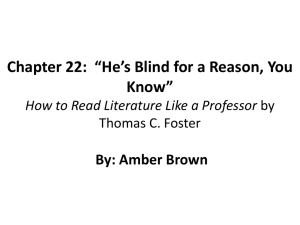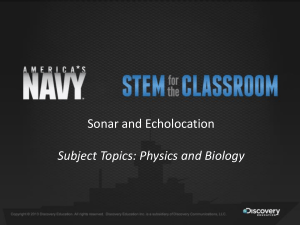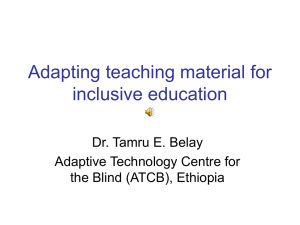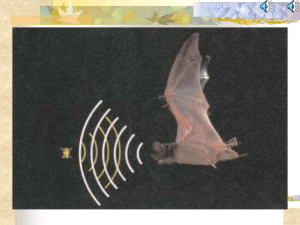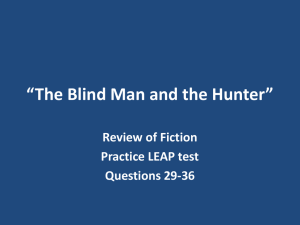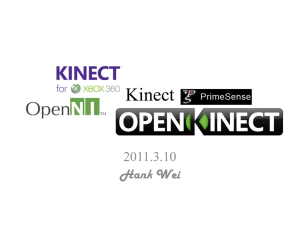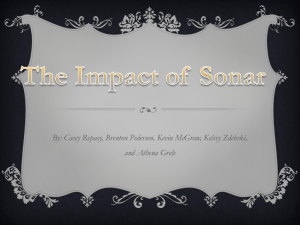Poster-Vorlage EPAEG Vertikal
advertisement
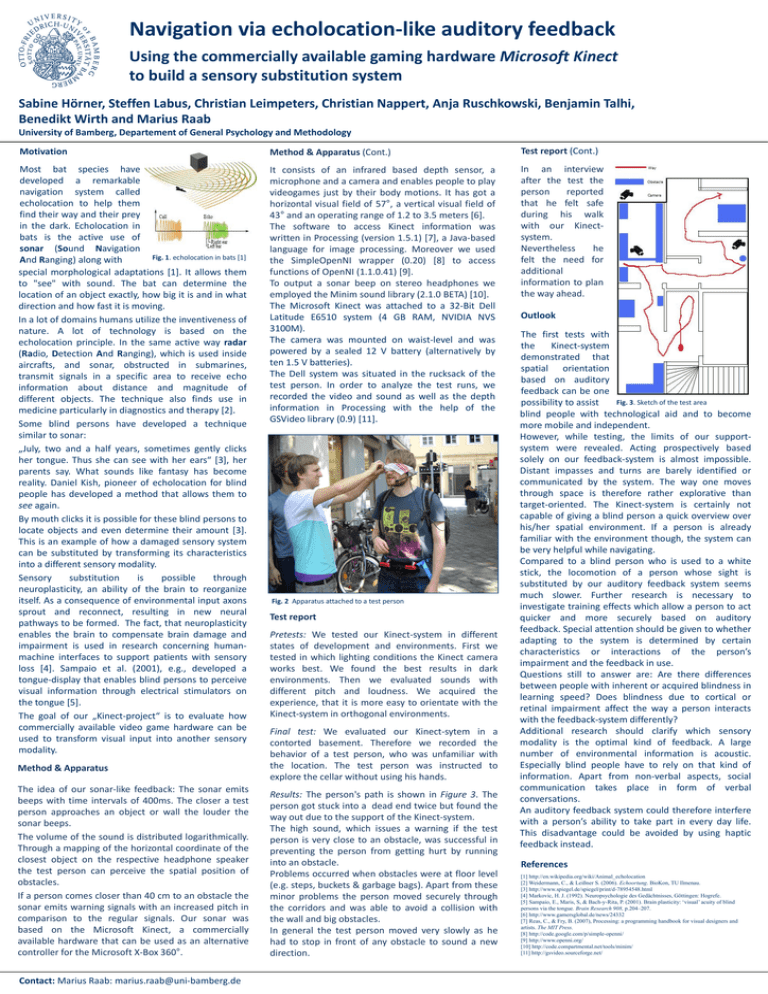
Navigation via echolocation-like auditory feedback Using the commercially available gaming hardware Microsoft Kinect to build a sensory substitution system Sabine Hörner, Steffen Labus, Christian Leimpeters, Christian Nappert, Anja Ruschkowski, Benjamin Talhi, Benedikt Wirth and Marius Raab University of Bamberg, Departement of General Psychology and Methodology Motivation Method & Apparatus (Cont.) Test report (Cont.) Most bat species have developed a remarkable navigation system called echolocation to help them find their way and their prey in the dark. Echolocation in bats is the active use of sonar (Sound Navigation Fig. 1. echolocation in bats [1] And Ranging) along with special morphological adaptations [1]. It allows them to "see" with sound. The bat can determine the location of an object exactly, how big it is and in what direction and how fast it is moving. In a lot of domains humans utilize the inventiveness of nature. A lot of technology is based on the echolocation principle. In the same active way radar (Radio, Detection And Ranging), which is used inside aircrafts, and sonar, obstructed in submarines, transmit signals in a specific area to receive echo information about distance and magnitude of different objects. The technique also finds use in medicine particularly in diagnostics and therapy [2]. Some blind persons have developed a technique similar to sonar: „July, two and a half years, sometimes gently clicks her tongue. Thus she can see with her ears“ [3], her parents say. What sounds like fantasy has become reality. Daniel Kish, pioneer of echolocation for blind people has developed a method that allows them to see again. By mouth clicks it is possible for these blind persons to locate objects and even determine their amount [3]. This is an example of how a damaged sensory system can be substituted by transforming its characteristics into a different sensory modality. Sensory substitution is possible through neuroplasticity, an ability of the brain to reorganize itself. As a consequence of environmental input axons sprout and reconnect, resulting in new neural pathways to be formed. The fact, that neuroplasticity enables the brain to compensate brain damage and impairment is used in research concerning humanmachine interfaces to support patients with sensory loss [4]. Sampaio et al. (2001), e.g., developed a tongue-display that enables blind persons to perceive visual information through electrical stimulators on the tongue [5]. The goal of our „Kinect-project“ is to evaluate how commercially available video game hardware can be used to transform visual input into another sensory modality. It consists of an infrared based depth sensor, a microphone and a camera and enables people to play videogames just by their body motions. It has got a horizontal visual field of 57°, a vertical visual field of 43° and an operating range of 1.2 to 3.5 meters [6]. The software to access Kinect information was written in Processing (version 1.5.1) [7], a Java-based language for image processing. Moreover we used the SimpleOpenNI wrapper (0.20) [8] to access functions of OpenNI (1.1.0.41) [9]. To output a sonar beep on stereo headphones we employed the Minim sound library (2.1.0 BETA) [10]. The Microsoft Kinect was attached to a 32-Bit Dell Latitude E6510 system (4 GB RAM, NVIDIA NVS 3100M). The camera was mounted on waist-level and was powered by a sealed 12 V battery (alternatively by ten 1.5 V batteries). The Dell system was situated in the rucksack of the test person. In order to analyze the test runs, we recorded the video and sound as well as the depth information in Processing with the help of the GSVideo library (0.9) [11]. In an interview after the test the person reported that he felt safe during his walk with our Kinectsystem. Nevertheless he felt the need for additional information to plan the way ahead. Method & Apparatus The idea of our sonar-like feedback: The sonar emits beeps with time intervals of 400ms. The closer a test person approaches an object or wall the louder the sonar beeps. The volume of the sound is distributed logarithmically. Through a mapping of the horizontal coordinate of the closest object on the respective headphone speaker the test person can perceive the spatial position of obstacles. If a person comes closer than 40 cm to an obstacle the sonar emits warning signals with an increased pitch in comparison to the regular signals. Our sonar was based on the Microsoft Kinect, a commercially available hardware that can be used as an alternative controller for the Microsoft X-Box 360°. Contact: Marius Raab: marius.raab@uni-bamberg.de Fig. 2 Apparatus attached to a test person Test report Pretests: We tested our Kinect-system in different states of development and environments. First we tested in which lighting conditions the Kinect camera works best. We found the best results in dark environments. Then we evaluated sounds with different pitch and loudness. We acquired the experience, that it is more easy to orientate with the Kinect-system in orthogonal environments. Final test: We evaluated our Kinect-sytem in a contorted basement. Therefore we recorded the behavior of a test person, who was unfamiliar with the location. The test person was instructed to explore the cellar without using his hands. Results: The person's path is shown in Figure 3. The person got stuck into a dead end twice but found the way out due to the support of the Kinect-system. The high sound, which issues a warning if the test person is very close to an obstacle, was successful in preventing the person from getting hurt by running into an obstacle. Problems occurred when obstacles were at floor level (e.g. steps, buckets & garbage bags). Apart from these minor problems the person moved securely through the corridors and was able to avoid a collision with the wall and big obstacles. In general the test person moved very slowly as he had to stop in front of any obstacle to sound a new direction. Outlook The first tests with the Kinect-system demonstrated that spatial orientation based on auditory feedback can be one Fig. 3. Sketch of the test area possibility to assist blind people with technological aid and to become more mobile and independent. However, while testing, the limits of our supportsystem were revealed. Acting prospectively based solely on our feedback-system is almost impossible. Distant impasses and turns are barely identified or communicated by the system. The way one moves through space is therefore rather explorative than target-oriented. The Kinect-system is certainly not capable of giving a blind person a quick overview over his/her spatial environment. If a person is already familiar with the environment though, the system can be very helpful while navigating. Compared to a blind person who is used to a white stick, the locomotion of a person whose sight is substituted by our auditory feedback system seems much slower. Further research is necessary to investigate training effects which allow a person to act quicker and more securely based on auditory feedback. Special attention should be given to whether adapting to the system is determined by certain characteristics or interactions of the person’s impairment and the feedback in use. Questions still to answer are: Are there differences between people with inherent or acquired blindness in learning speed? Does blindness due to cortical or retinal impairment affect the way a person interacts with the feedback-system differently? Additional research should clarify which sensory modality is the optimal kind of feedback. A large number of environmental information is acoustic. Especially blind people have to rely on that kind of information. Apart from non-verbal aspects, social communication takes place in form of verbal conversations. An auditory feedback system could therefore interfere with a person’s ability to take part in every day life. This disadvantage could be avoided by using haptic feedback instead. References [1] http://en.wikipedia.org/wiki/Animal_echolocation [2] Weidermann, C., & Leißner S. (2006). Echoortung. BioKon, TU Ilmenau. [3] http://www.spiegel.de/spiegel/print/d-78954548.html [4] Markovic, H. J. (1992). Neuropsychologie des Gedächtnisses, Göttingen: Hogrefe. [5] Sampaio, E., Maris, S, & Bach-y-Rita, P. (2001). Brain plasticity: ‘visual’ acuity of blind persons via the tongue. Brain Research 908, p.204–207. [6] http://www.gamersglobal.de/news/24332 [7] Reas, C., & Fry, B. (2007), Processing: a programming handbook for visual designers and artists. The MIT Press. [8] http://code.google.com/p/simple-openni/ [9] http://www.openni.org/ [10] http://code.compartmental.net/tools/minim/ [11] http://gsvideo.sourceforge.net/
